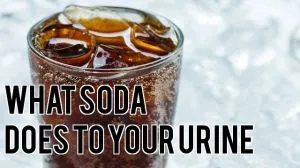
- Share on Facebook1313
- Share on Pinterest
- Share on Twitter
Soda is usually demonized for its insane sugar content (usually in the form of high fructose corn syrup), but did you know that soda can harm your health in other ways too? One of these ways is by starving your body of the precious minerals you need to maintain a healthy body, which can take a particularly harsh toll on your bones.
Here’s how it works:
Soda contains phosphoric acid
You may recognize the name of this ingredient from soda labels, as it’s present in many soda beverages, from regular, to diet, to plain old soda water. This colorless, odorless acid is added to sodas to preserve the fizz and bubbles that keep people coming back for more.
It’s the chemical that gives soda that initial sharp “bite” when you first open it and start drinking it. It also serves to prevent mold and bacteria from growing in the soda, as they would normally thrive in such a sugary environment!
Sounds good, right? Except that phosphoric acid wreaks havoc with our body’s ability to absorb and use crucial minerals like calcium and magnesium. Not only does it prevent these two minerals from being absorbed, it also naturally seeks out calcium in the body, binds with it, and then heads directly for your bones. This is a big problem for your skeleton, as the compound may actually dissolve your bones — just like it does rust. This is actually a common use for the chemical.
What all of this means is that soda consumption may lead to the following:
Calcium deficiency
Calcium is one of the most important nutritional building blocks in our body. This mineral helps to maintain strong, healthy bones and teeth, and also aids in vascular contraction and muscle function, among other essential functions.
Signs and symptoms of calcium deficiency include muscle cramps, insomnia, tooth decay, and weak and brittle nails. Not to mention the fact that getting enough calcium is crucial for bone health, as long-term deficiency can lead to osteoporosis.
If you fear you may be calcium deficient, it is important to see a medical practitioner. After you end your love affair with soda, here are some ways you can increase the calcium in your diet:
While milk is the most common sources of calcium, many people have an intolerance to dairy, are vegan, or just don’t like the taste of milk. Fortunately, it’s not the only way to get the 1,000 mg per day that’s recommended for adults between the ages of 19 and 50. Try these other great sources.
Kale: Kale has become one of the most popular superfoods in recent years, but if you needed yet another incentive to eat your greens, just one cup of raw kale is packed with 90 mg of calcium, which means a 3.5-cup of kale salad offers more of this bone-building mineral than an 8-ounce glass of milk.
Black-eyed peas: Black-eyed peas aren’t just a popular band: these legumes contain 185 mg of calcium in just a one-half cup, as well as being packed with potassium and folate.
Sesame seeds: Just one ounce of sesame seeds contains 280 mg of calcium — almost as much as one cup of milk. They can also help reduce blood pressure and inflammation, and may even aid in battling against certain cancers.
Seaweed: Seaweed is an amazing nutrient-rich superfood, filled with vitamin B12, folate, iodine and magnesium. It also packs 168 mg of calcium in each 100-gram serving.
Almonds: Almonds are one of the world’s most nutritionally dense nuts, loaded with incredible amounts of nutrients per calorie and ounce. Just a one-ounce serving offers 80 mg of calcium. Almonds are also known to help regulate blood sugar levels, promote weight loss and cut cholesterol.
Magnesium deficiency
Magnesium deficiency is super common in the US, as almost 70 percent of Americans are thought to be deficient in the mineral. Sometimes called the “relaxation” mineral, magnesium is responsible for over 300 processes in the body, so you really want to get enough of it!
It’s critical in maintaining normal bone, muscle, nerve, heart, immune function, and blood glucose control. Research now supports that magnesium may play an important role in protecting against type 2 diabetes.
This mineral also aids nitric oxide in allowing artery walls to relax, resulting in more efficient blood flow. A recent study found that a magnesium intake of 500 mg to 1,000 mg aids in reducing blood pressure, yet works most efficiently when the potassium to sodium levels are at the optimal 2:1 ratio.
Signs that you may be deficient in magnesium include anxiety, depression, insomnia, lethargy, depression, constipation, hypertension, pain, muscle cramps, headaches, anger, brain fog, tension and behavioral changes.
In terms of magnesium deficiency, phosphoric acid isn’t the only ingredient that may cause this! Sugar is the culprit again here, as it’s known to deplete magnesium in the body, along with potassium and other minerals.
Besides quitting soda, try increasing your intake of magnesium-rich foods, nuts, legumes, and green leafy vegetables, to achieve normal levels.
As babies, our bones are soft and certain bones are not even completely matured at birth. An infant’s skull is made up of six separate cranial bones (the frontal bone, the occipital bone, two parietal bones, and two temporal bones). These bones are held together by strong, fibrous, elastic tissues called cranial sutures.
The spaces between the bones where the sutures are (sometimes known as “soft spots”) are called fontanels. The cranial bones remain separate for about 12-18 months. They then grow together (fuse) as part of normal growth. They stay fused throughout adulthood.
In fact our bones go through growth stages through childhood into adulthood but never really stop growing, or should we say, “regrow.” It is possible to grow new bone every 10 years, however, for women, after our thirties, we lose estrogen and therefore lose bone. As women go through menopause, without the right nutrition and exercise, our bones become brittle and we acquire osteopenia or osteoporosis.
Some studies have linked soda consumption with osteoporosis, as well as the fact that sodas often replace calcium-filled drinks like milk in people’s diets.
Step one to avoid osteoporosis — quit drinking soda. Other things that rob the body of calcium and contribute to osteoporosis are stress, poor diet, and excessive amounts of alcohol, caffeine and salt. Even if you take calcium supplements, these foods can deplete your calcium supply and cause bone to deteriorate. Changing your diet, the right supplements, exercising and limiting these types of food can help keep bones strong.
The takeaway here is that if your waistline isn’t a good enough reason to give up soda, the health of your bones should be! Time to quit the fizzy poison TODAY.
-The Alternative Daily
Sources:
http://www.newsmax.com/FastFeatures/deficiency-of-calcium-deficiency/2014/09/29/id/386529
http://www.huffingtonpost.com/dr-mark-hyman/magnesium-the-most-powerf_b_425499.html?ir=India
https://www.thealternativedaily.com/4-methylimidazole-and-4-other-reasons-to-dump-your-soda-down-the-drain
http://www.webmd.com/osteoporosis/features/soda-osteoporosis?page=2
http://www.nutraingredients.com/Research/Magnesium-may-benefit-blood-pressure-in-hypertensives
- Share on Facebook1313
- Share on Pinterest
- Share on Twitter


